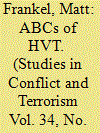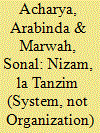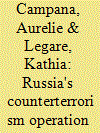|
|
|
Sort Order |
|
|
|
Items / Page
|
|
|
|
|
|
|
| Srl | Item |
| 1 |
ID:
106617


|
|
|
|
|
| Publication |
2011.
|
| Summary/Abstract |
The use of high value targeting (HVT)-using military and police forces to kill or capture leaders of insurgent and terrorist groups-has increased exponentially since the terrorist attacks of September 11, 2001. HVT operations have become the primary tool of the United States for combating Al Qaeda and its affiliates worldwide, and while these operations have eliminated scores of terrorists and insurgents from the battlefield, they haven't always led to strategic success. Utilizing a data set of 20 distinct HVT campaigns dating back to the end of World War II, this article will highlight the positive and negative effects of HVT efforts throughout history and identify six key lessons from past campaigns and their implications for the United States. The body of the paper looks at the important issues inherent to any HVT campaign, including the benefits of having a local force carry out the campaign, the importance of incorporating HVT into a larger counterinsurgency strategy, and the necessity of understanding the dynamics of the group being targeted. The United States has historically struggled in all of these areas, leading to difficulties in achieving success through HVT operations, but these historical lessons also provide opportunities for progress. The article concludes with important implications for the United States and identifies strategies for improvement in these pivotal areas, including expanding relationships with host governments, leveraging new technologies, and contemplating unique ways to approach target sets. Failure to make these changes, the article argues, will leave the United States with the same strategic failures it had with the infamous "deck of cards" in Iraq, where the focus on HVT at the expense of counterinsurgency both helped create and failed to stop the spread of a nationwide insurgency.
|
|
|
|
|
|
|
|
|
|
|
|
|
|
|
|
| 2 |
ID:
106618


|
|
|
|
|
| Publication |
2011.
|
| Summary/Abstract |
This study offers the concept of an International Terror Crisis (ITC) as a new unit of analysis in terror research. An ITC occurs when a terror act triggers inter-state hostility, violence, or war engendering regional or global stability. By using international crisis as a gauge for instability, this article demonstrates the value of ITCs and compares 26 ITCs to all international crises from 1918 to 2006. Findings show an increase in ITC occurrence, terror violence, and inter-state war, but a decrease in less severe inter-state violence. These changes, apparent in ITCs alone, indicate the dangers of terror in world politics.
|
|
|
|
|
|
|
|
|
|
|
|
|
|
|
|
| 3 |
ID:
106616


|
|
|
|
|
| Publication |
2011.
|
| Summary/Abstract |
The decline of the terrorist organization and the phenomenon of "homegrown" or "leaderless" jihad have led to the perception that the terrorist threat has moved from commander-cadre organizations to diffused networks or cells and individuals. However, using the November 2008 terrorist attacks in Mumbai, this article demonstrates that organizations do matter in terrorism. In other words, to produce successful and high impact attacks, terrorists do need some form of organization. Even leaderless jihad is not truly leaderless or devoid of some form of organization as the proponents of this concept claim. Moreover, even as the environmental entropy-reduction in the capacity of the environment to support an organization-has become distinctly pronounced in respect of terrorism, some groups did not have to make the same tradeoff as others due to their favorable position vis-a-vis the state they operate in. Therefore, these groups are capable of producing attacks of high operational sophistication with (a) strong organization and (b) state support to maintain that organization.
|
|
|
|
|
|
|
|
|
|
|
|
|
|
|
|
| 4 |
ID:
106619


|
|
|
|
|
| Publication |
2011.
|
| Summary/Abstract |
This article analyzes how Russian Federal policies evolved between 1999 and 2005 to justify the policy of "Chechenization" and the legitimization of an autocratic-style regime in Chechnya. It argues that this strategy was progressively elaborated during the conflict as a result of institutional competition between three main Federal agencies (the Presidential Administration, the secret services (FSB)), and the military over the framing of the conflict. This process paved the way for the formation of the "totalizing frame" under the leadership of the Kremlin, which incorporated various discursive constructions into one coherent and exclusive interpretation of the conflict.
|
|
|
|
|
|
|
|
|
|
|
|
|
|
|
|
|
|
|
|
|